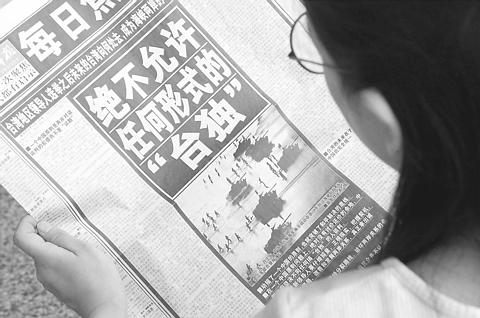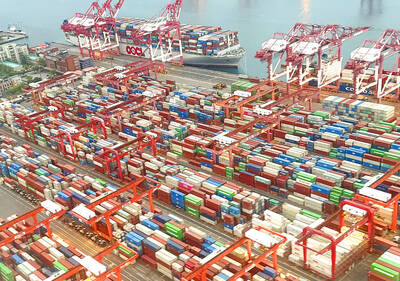In the wake of recent reports from the US that criticized Taiwan's military, debate has continued unabated in both capitals over the sale of the Aegis combat system.
The US has levelled blame against Taiwan for its command inefficiency, weaknesses in procurement priorities and leaving holes in the country's defenses.
Many in Taiwan argue that the Aegis system -- which can detect, track and kill multiple missiles and other targets simultaneously -- is just what Taiwan needs in the face of China's growing threats.

PHOTO: REUTERS
Others say Taiwan needs to learn how to better use what it has already before it can effectively incorporate new military hardware
In fact, as staff reporter William Ide reports, a possible refusal by Washington to sell the system "could be a good opportunity for the new government and reform minded leaders in the military" to take stock of its abilities and increase its military prowess.
Aegis. The word has, in recent months, become something of a catch word among policy makers and analysts in both Washington and Taipei -- as well as their counterparts in Beijing -- all of whom are fiercely debating the future of Taiwan's weapons acquisitions.
Aegis is itself not a weapon, but a combat system, or, as the US Navy states, "a total combat system," which uses an advanced radar system to detect, track and destroy hundreds of targets simultaneously. Its advanced computer-based command system has made it one of the world's leading combat management systems.
Much of the debate over Aegis has focused on the question of whether Washington should supply the technology to Taiwan. But some analysts say that even if the US refuses to sell Taiwan four of the Aegis-equipped destroyers -- a likely scenario, they say -- it would not necessarily represent a serious setback for the country.
In fact, the refusal could be a good opportunity for the new government and reform-minded leaders in the military, to put more emphasis on strengthening the island's ability to effectively use the weapons systems it has already procured.
"If you spend the money, time and effort on improving in some of the other areas, then it may not actually be as bad as some have pointed out," said Damon Bristow, head of the Asia Program at the Royal United Services Institute for Defense Studies.
With the recent release of several hard-hitting reports on the topic, other areas such as security decision-making and air defense capability have been the focus of a growing debate among military analysts in Taiwan as well as overseas, particularly in the US, Taiwan's leading weapons provider.
One report, released in December of last year, conducted by Chinese military specialist Michael Swaine from the Rand Corporation, looked at Taiwan's national security decision-making process, particularly the weaknesses in elements that guide strategy, organization and procurement decisions.
More recently, a 40-page report produced by officers of the US Joint Chiefs of Staff and policy makers at the Office of the Secretary of Defense, was leaked to the Washington Post.
The report blamed what it said were holes in Taiwan's air defense capability due to rivalries between the different armed forces, the shortage of professional soldiers and a lack of senior enlistees to operate weapons systems.
Both reports have attracted considerable attention among the local media and military analysts.
A wake up call for Taiwan's military
The leaked report, says Jamestown Foundation senior fellow Richard Fisher, represents Assistant Defense Secretary Kurt Campbell's "final gift to the defense of Taiwan."
"It was designed to be a wake-up call for the US and Taiwan," said Fisher. "For 20 years, we have been selling hardware without the appropriate software, which quite often only flows from the daily multi-level interaction from normal allied military relations."
While military analysts feel the chances are slim that Taiwan will actually acquire Aegis -- not to mention air-to-air AMRAAM missiles, ballistic missile counters, anti-radar HARM missiles nor its longtime request for submarines -- other smaller but significant purchases could make up the shortcoming.
"What will happen is, you will see all these funny areas that don't look like they are important because they are not big ships or big purchases, because they are technologies, rather than platforms. But they are actually more important than such purchases," Bristow said.
"If they don't get Aegis, they may get other things they need to fill the gaps, like data-links," Bristow said.
"It's an open-secret that Taiwan's F-16s are unable to communicate directly with its Hawkeye Airborne Early Warning and Control (AEWAC) planes," Bristow said.
Fisher thinks the whole problem is best answered with Aegis.
"`Blood or money' is the age-old question for any government. I believe Taiwan can buy the systems necessary to deter a People's Liberation Army attack," Fisher said. "If Taiwan really wants to prevent a war in the Strait, then Aegis will only be the first installment, if you will."
While Rand's Swaine said he was not actually opposed to the sale of Aegis, Taiwan could still do more to strengthen its ability to use its existing weapons systems, and to carefully consider how it would fit the Aegis system into its defense framework.
"Taiwan most needs to get truly serious about developing genuine war fighting capabilities, and using the very capable systems that it already has in hand, but in many instances does not yet effectively use," Swaine said.
"This requires more money for the military, longer terms of enlistment for soldiers, better pay and other incentives, more communication and coordination of roles and missions among the three armed services."
Bristow pointed out that a better use of existing funds could also be used to help keep more trained F-16 pilots in the service from shifting to commercial airlines and navy electronic warfare officers from being siphoned off to work for high-tech companies, Bristow said.
While Taiwan's military is aware of the problems and is working to overcome them, it must also overcome deeply-entrenched internal organizational problems, as well as its attitude, Swaine added.
"The Taiwan public should stop thinking that the acquisition of this or that advanced weapon system from Washington will address their security problems. They need to start getting serious about defense, and commit resources and energy to that effort," he said.
Pricey and problematic
While the Aegis system could be an ideal counterbalance to the ballistic missile threat from China, it is just as pricey as it is problematic, analysts said.
Aegis-equipped destroyers, which carry an estimated price tag of over US$1 billion per ship, would be the ideal platform to help counter an ongoing build up of Chinese M-9 and M-11 short range ballistic missiles directly across the Taiwan Strait.
Not only that, but the platform -- originally designed to defend carrier battle groups against a variety of Soviet attacks -- could also offer anti-submarine capability, as well as early warning, naval air defense, anti-ship, and anti- missile functions, Swaine pointed out.
As part of its anti-missile capability, some analysts said the system would also be capable of countering China's newly purchased Sovremmeny-class destroyers, equipped with sea-skimming Sunburn missiles.
The Sunburn missile is especially lethal, because of its ability to skim the ocean's surface until nearing its target, then soaring upward before finally coming down on enemy ships from above.
But while the sale ostensibly meets growing defense needs, there are a number of glaring political and practical obstacles that stand in the way, analysts said.
Not only would the Navy have difficulty integrating the destroyers, but it is still unclear how the ships would fit into the overall structure of Taiwan's armed forces, or how they could be protected, Swaine said.
Taiwan "would not receive the ships for at least five years even if they were to order them today, so they would have some time to improve their capacity to absorb them, but it would be a major challenge," Swaine said.
Swaine also added much of Taiwan's existing naval forces would be needed to protect the Aegis ships.
"[The Navy] would probably need to deploy them as part of a flotilla of ships, including the Perry-class and Lafayette-class ships all protecting one another," he said.
"Such a configuration will almost certainly further constrain the operational flexibility of the ROC Navy, since many of its best ships would be tied to operations involving the Aegis ships," he added.
The Aegis system does have the potential of serving as part of either a lower or upper tier of a naval ballistic missile defense system. But this, in turn, brings with it not only strategic concerns, but political ramifications as well.
The desire to establish such a function could increase interaction between the military of the US and Taiwan, something China does not look fondly upon, analysts pointed out.
"They [China] realize that the Taiwanese haven't trained together with the Americans in 20 years," Bristow said. "That's really what bugs the Chinese. It could bring the forces together when all they want to see is them driven apart."
"And this is the conundrum that people in the US realize. If you sell Aegis in whatever form, it's going to cause tensions from the Chinese," he added.
The purchase of an upper tier, Aegis-based missile defense system could also give a very false sense of security against China's very real ballistic missile threat, leading some to believe Taiwan would have more leeway to determine its own fate, Swaine said.
"Taiwan citizens and leaders might believe that they have a highly effective counter to China's most potent military threat, and thus determine that they could and should proceed to increase Taiwan's permanent separation from the mainland," he said.

MORE VISITORS: The Tourism Administration said that it is seeing positive prospects in its efforts to expand the tourism market in North America and Europe Taiwan has been ranked as the cheapest place in the world to travel to this year, based on a list recommended by NerdWallet. The San Francisco-based personal finance company said that Taiwan topped the list of 16 nations it chose for budget travelers because US tourists do not need visas and travelers can easily have a good meal for less than US$10. A bus ride in Taipei costs just under US$0.50, while subway rides start at US$0.60, the firm said, adding that public transportation in Taiwan is easy to navigate. The firm also called Taiwan a “food lover’s paradise,” citing inexpensive breakfast stalls

TRADE: A mandatory declaration of origin for manufactured goods bound for the US is to take effect on May 7 to block China from exploiting Taiwan’s trade channels All products manufactured in Taiwan and exported to the US must include a signed declaration of origin starting on May 7, the Bureau of Foreign Trade announced yesterday. US President Donald Trump on April 2 imposed a 32 percent tariff on imports from Taiwan, but one week later announced a 90-day pause on its implementation. However, a universal 10 percent tariff was immediately applied to most imports from around the world. On April 12, the Trump administration further exempted computers, smartphones and semiconductors from the new tariffs. In response, President William Lai’s (賴清德) administration has introduced a series of countermeasures to support affected

CROSS-STRAIT: The vast majority of Taiwanese support maintaining the ‘status quo,’ while concern is rising about Beijing’s influence operations More than eight out of 10 Taiwanese reject Beijing’s “one country, two systems” framework for cross-strait relations, according to a survey released by the Mainland Affairs Council (MAC) on Thursday. The MAC’s latest quarterly survey found that 84.4 percent of respondents opposed Beijing’s “one country, two systems” formula for handling cross-strait relations — a figure consistent with past polling. Over the past three years, opposition to the framework has remained high, ranging from a low of 83.6 percent in April 2023 to a peak of 89.6 percent in April last year. In the most recent poll, 82.5 percent also rejected China’s

PLUGGING HOLES: The amendments would bring the legislation in line with systems found in other countries such as Japan and the US, Legislator Chen Kuan-ting said Democratic Progressive Party (DPP) Legislator Chen Kuan-ting (陳冠廷) has proposed amending national security legislation amid a spate of espionage cases. Potential gaps in security vetting procedures for personnel with access to sensitive information prompted him to propose the amendments, which would introduce changes to Article 14 of the Classified National Security Information Protection Act (國家機密保護法), Chen said yesterday. The proposal, which aims to enhance interagency vetting procedures and reduce the risk of classified information leaks, would establish a comprehensive security clearance system in Taiwan, he said. The amendment would require character and loyalty checks for civil servants and intelligence personnel prior to